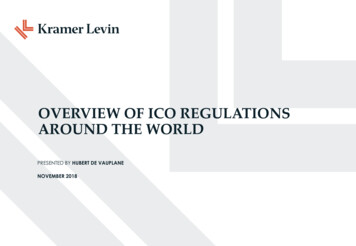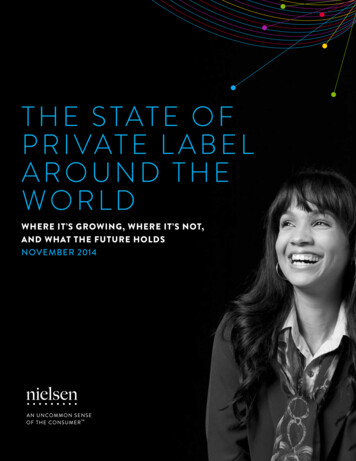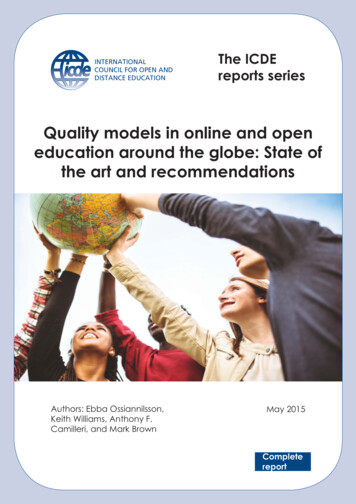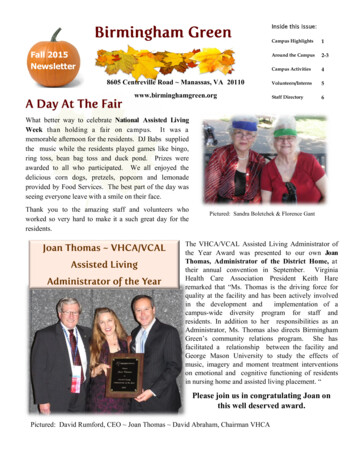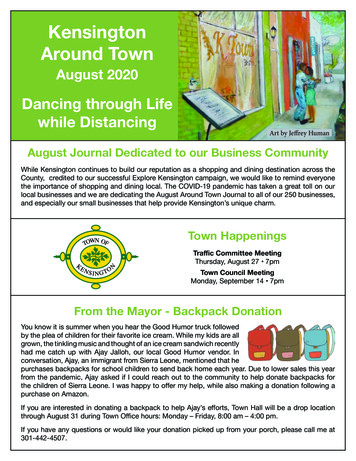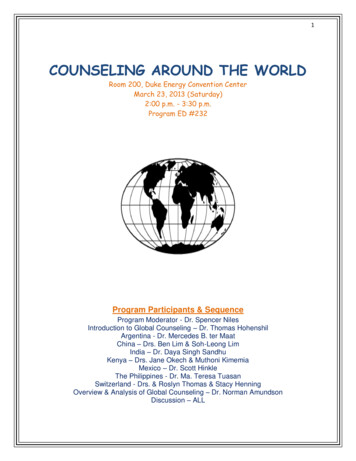
Transcription
1COUNSELING AROUND THE WORLDRoom 200, Duke Energy Convention CenterMarch 23, 2013 (Saturday)2:00 p.m. - 3:30 p.m.Program ED #232Program Participants & SequenceProgram Moderator - Dr. Spencer NilesIntroduction to Global Counseling – Dr. Thomas HohenshilArgentina - Dr. Mercedes B. ter MaatChina – Drs. Ben Lim & Soh-Leong LimIndia – Dr. Daya Singh SandhuKenya – Drs. Jane Okech & Muthoni KimemiaMexico – Dr. Scott HinkleThe Philippines - Dr. Ma. Teresa TuasanSwitzerland - Drs. & Roslyn Thomas & Stacy HenningOverview & Analysis of Global Counseling – Dr. Norman AmundsonDiscussion – ALL
2INTRODUCTION TO GLOBAL COUNSELINGThomas H. HohenshilVirginia Techthohen@vt.eduThis convention program is built around ACA’s first global counseling book whichwas recently published. The book, Counseling Around the World: An InternationalHandbook (Thomas Hohenshil, Norman Amundson, & Spencer Niles, Editors) providesinformation about counseling activities in 40 different countries located on sixcontinents. After an introductory section which describes global diversity issues,chapters are devoted to counseling services for countries in Africa, Asia, Europe, theMiddle East, North America, Oceania, and South and Central America. Each chapterfollows a common format which includes the history and current state of counseling inthe country, techniques that have been shown to work best, diversity issues specific tothe country, counselor education and training, and possibilities for the future ofcounseling.Until recently there wasn’t a comprehensive and systematic global study of thecounseling profession. Then, about two years ago the American CounselingAssociation (ACA) contracted with Norman Amundson (University of British Columbia),Thomas Hohenshil (Virginia Tech), and Spencer Niles (The Pennsylvania StateUniversity) to develop a book on the topic of global counseling .To generate the content for the book, they developed a method to systematicallystudy the profession from a global perspective by having leading experts from 40countries describe the status of counseling using a standard reporting format. Thecountries were selected to represent each of the continents, except for Antarctica. Thechapter authors were chosen using a variety of sources, including CESNET-L andother discussion groups, a review of the international literature, and recommendations.A total of 109 researchers, counselors, and counselor educators participated inwriting the various chapters. The book is designed for use as a text for graduatecourses in global counseling, multi-cultural courses, and various introductory andprofessional issues courses. It is also a valuable resource for practicing counselors andother mental health professionals who provide services for persons from a variety ofcountries.
3COUNSELING IN ARGENTINAMercedes B. ter Maat, Ph.D., LPC, ATR-BCtermaat@nova.eduHistory1987 - a group of psychologists started a program with a humanistic, personcentered focus.1990 - Holos San Isidro, the first institution to offer a counseling program wasfounded by Andres Sanches Bodas.1992 counseling became an official career. The first class of 18-10 students enrolledThe focus, as it has also been in other parts of the world, was to shy away frompsychology and psychiatry, very prominent in Argentina (still).The founders wanted, as previously mentioned, a humanistic, person-centeredapproach that focused on well-being, not on pathology and problems.Counseling programs (and graduates) have multiplied not only in Buenos Aries butin state capitals and universities around the nation.Graduates work in a variety of settings, yet they continue to struggle with turf issues,challenged by psychologists and school psychologists in both mental health andschool settings.Argentine Association of Counselors was born (membership, ethical codes,standards of practice).NBCC Argentina (under the guidance of NBCC International) was created to developand regulate a certification credential for those who met its educational andtraining standards.The program at Holos is presently exploring the feasibility of CACREP accreditation.
4Areas of growthPalliative care, school counseling, multicultural counseling, research specific tocounseling efficacy, peer counseling, counseling and the identification ofemotions, ethics.There is a need for research on all aspects of the counseling profession (identity andcounseling efficacy). Apprehension exists among professionals and studentsalike.Mental Health CounselingDuring the first 10 years counseling was limited to private offices and institutions thathad agreements with university programs to place practicum and internshipstudents-in-training. These included community agencies and churches of varieddenominations. Since then, counseling has expanded into mental healthhospitals and clinics.Now they work side by side and in teams with psychologists, psychiatrists, andsocial workers without conflict, understanding the unique contributions that eachdiscipline offers for clients.School counselingSchool counseling as a profession is not widely recognized; not regulated by theMinistry of Education; difficult to seek employment in educational settings(workshops)They are not mandated as essential to the education setting and compete withschool psychologists (psicopedagogos), who have been in schools since the late1990s.School psychologists provide student testing and assessment as well as therapy,providing a barrier to the employment of school counselors.ClosingVIII Congreso Internacional de Counseling de las Americas (Sept. 6-8, 2012;Argentina)25th year Anniversary - Counselors come from different walks of life; seem to loveHolos and the counseling profession.Counseling in Argentina following similar trajectory as in the US: navigating themental health field; unlimited talks with other mental health professionals;understanding similarities, differences, and turfs (psychology, social work, schoolpsychology).
5COUNSELING IN CHINABen K. Lim, Bethel University, San Diegogembala51@gmail.comSoh-Leong Lim , San Diego State Universityslim@mail.sdsu.eduChina has at least100 million people suffering from various psychologicalproblems. Mental illness is her most widespread disease. Industrialization and the rapidurbanization of the rural population has contributed to a high suicide rate of around 2030 per 10,000 compared to the worldwide average rate for suicide of 14 per 10,000(Lim, Lim, Michael, Cai, & Schock, 2010). It was encouraging to have the support of theChinese leadership when both the 2008 5th World Congress for Psychotherapy and the2010 International Psychiatry Congress were held in Beijing. Different authors over thelast decade have chronicled the historical development of counseling in China (Qian,Smith, Chen, & Xia, 2002; Yip, 2005; Lim et al., 2010)There are three broad groups of counselors in China (Hou & Zhang, 2007). Thefirst group serves the severely mentally ill in hospital settings. The second group workswithin the educational system of the country, where counseling includes political andthought education as directed by the Ministry of Education. The third group ofcounselors consists of those working with commercial companies and those practicingin the private sector. Most of the latter are found in the larger coastal cities on the eastcoast.The Chinese Psychological Society (CPS) and the Chinese Association of MentalHealth (CAMH) are the two most important professional counseling associations inChina. Both are registered with the Chinese Science and Technology Association and,therefore, have governmental legal sanction. Both promote the profession throughaccreditation, research and journal publication. The CPS also awards mastercounselors to be Registered Psychologists (注册心理师).
6The government has begun certifying the profession. These include theCertificate of Psychological Counseling and the Certificate of Marriage and FamilyTherapy (National Labor Bureau, Ministry of Labor and Social Security) and theCertificate of Psychological Psychotherapy (Ministry of Health and Ministry ofPersonnel.) Similar to the Confucian-based entrance examination (ke ju 科举), thecounseling certification programs tend to emphasize book learning and theoreticalknowledge with minimal practical application. The certification of counselors by theNational Counseling Licensing Board comes in three levels. Level Three counselors arethose with a bachelor degree who successfully complete the government approvedcourses and examination (covering such areas as basic counseling skills,developmental and social psychology, personality disorders, and psychologicalassessments). Those who pass Level Three can proceed to study the Level Twocourses and take the Level Two examination covering such areas as advancedcounseling skills, diagnosis, and assessment of mental disorders, and the use ofvarious psychometric inventories. Level One is still on the drawing board. It is reservedprimarily for those who have qualifying doctoral degrees in the fields of education,medicine, or counseling and have worked as therapists for at least three years. By July2006, there were 112 locations preparing candidates for Level 3 and Level 2 Certificateof Psychological Counseling examinations; and by September, 2007 there were120,000 certified psychology counselors in China (Kong & Xu, 2008).Most counselors draw from a variety of western theoretical models (such asCognitive Behavioral Therapy, Gestalt Therapy, Object Relations, Solution FocusedTherapy, Person-centered Therapy and Satir Conjoint Family Therapy). At the sametime, there are efforts at integrating traditional Chinese ideas of holistic health such asTraditional Chinese Medicine (TCM 中医) with western psychotherapy (Hou & Zhang,2007; Shu, 2003). Confucianism and Taoism influence the practice of counseling inChina, e.g., Chinese Taoist Cognitive Psychotherapy (Zhang, et al., 2002). Other fromof integration include Chinese music and calligraphy, mindfulness practice, Zen ideas,mind-body holism in TCM, acupuncture, and self-soothing techniques such as taiji(太极) and qigong (气功). In counseling, the Confucian doctrine of the Mean (zhongyong中庸) can guide the Chinese counselor towards an integrated balanced practicethat incorporates the best of eastern and western traditions.Overall, there is still a strong social stigma often associated with mental illnesses,which in China are usually treated in hospitals and in the criminal justice system. Mostcounselors see only individuals, and usually female clients, who are more amenable toask for help. Culturally this is understandable, as most people prefer to solve theirproblems within the family rather than involve outsiders. However, with the family underincreasing stress, there is an urgent need for family counseling in China. For such work,an understanding of Chinese thinking and Chinese contextual variables is useful. Filialpiety (xiao孝), benevolence (ren 仁),propriety(li礼), and harmony (he 和) form thebedrock of any counseling involving more than one person in the counseling room. The
7counselor’s ability to reframe and depathologize family dysfunctions helps couples andfamilies to continue in counseling. Gao (2001) noted that Chinese style of counselingtends to be more directive. Since counseling is on its ascendency and slowly gainingacceptance, it is important that counseling be done in an ethical manner especially inthe Chinese context where relationships (guanxi 关系), favors (renqing 人情 ) and facesaving (mianzi 面子) can present ethical dilemmas as they relate to dual relationships,boundaries, and confidentiality. The CPS together with CAMH, have formulated a codeof ethics covering all areas of training, research, and professional practice (CPS, 2007;Qian, Gao, Yao, & Rodriguez, 2009).There are informal paraprofessional counseling approaches that may not be asstigmatizing such as peer counseling in schools, voluntary mediation in the community,telephone hotlines and suicide counseling, and disaster relief. In addition to the above,Chinese counselors utilize the internet for therapy and where available, for supervision.A collaborative effort is underway between the Department of Labor and Hua-XiaPsychCn, an innovative Web-based organization, to train lay counselors (Huang, 2005).Some challenges for counselors in China are the sparse counseling services forthe 54 nationally recognized ethnic minorities, the one-child family policy withpreference for males which result in gender imbalance, the widening social class gapbetween the rich and poor, rural-west to urban-east migration that create greatsociological and psychological stress to individuals, families, and communities, and thegenerational differences result in breakdown of filial piety. The Chinese PsychologicalSociety (2004) reported that the ratio of counselors to the population is 2.4 per 1 millionpeople. 2.4 per 1 million people. This is a poor ratio compared to the United Stateswhere there are 3000 counselors per million people. Overall, there have not beenenough counselors trained to meet the burgeoning mental health needs of the country(Lim et al., 2010).ReferencesChinese Psychological Society. (2004). Psychology in China [Electronic Version]. 28thInternational Congress of Psychology. Retrieved December 31, 2006 nese Psychological Society (CPS). (2007). Code of ethics for counseling and clinicalpractice. Beijing, China: Author.Gao, Y. (2001). Directive approach to telephone counseling in the People’s Republic ofChina: Underlying cultural traditions and transitions. The CounselingPsychologist, 29(3), 435-453 doi: 10.1177/0011000001293007
8Hou, Z., & Zhang, N. (2007). Counseling psychology in China. Applied Psychology: AnInternational Review, 56(1), 33-50.Huang, W.-J. (2005). An Asian perspective on relationship and marriage education.Family Process, 44(2), 161-173.Kong, Q., & Xu, D. (2008). Resear
23.03.2013 · Smith, Chen, & Xia, 2002; Yip, 2005; Lim et al., 2010) There are three broad groups of counselors in China (Hou & Zhang, 2007). The first group serves the severely mentally ill in hospital settings. The second group works within the educational system of the country, where counseling includes political and thought education as directed by the Ministry of Education. The third group of .


